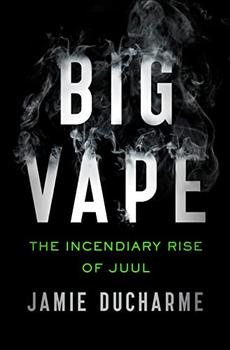Summary | Excerpt | Reviews | Beyond the Book | Readalikes | Genres & Themes | Author Bio

The Incendiary Rise of Juul
by Jamie Ducharme
Even after that discovery, Ariel never saw store shelves. There was no way to market it. If BAT released its new and innovative product and bragged about how safe it was, the company would be tacitly admitting that its regular cigarettes weren't safe. "There was no reason to make it," says tobacco historian and Stanford professor Robert Proctor. Doing so would only rock the boat.
Tobacco companies weren't the only ones who saw promise in a "safer" cigarette. Soon after the 1964 surgeon general's report entitled "Smoking and Health," public health officials began touting the idea known as "harm reduction," the concept of reducing the consequences associated with a risky behavior rather than solely trying to get people to quit that risky behavior. Providing drug users with clean needles is a common example of harm reduction, but the concept has a long history in the tobacco world, too. In the 1960s, health officials recommended pipes, cigars, and chewing tobacco as safer options than cigarettes. Public health leaders also readily accepted and promoted filtered and low-tar cigarettes, not yet realizing that these weren't much better than traditional cigarettes. These recommendations got people thinking that there might be a continuum of risk, with some dangerous products less harmful than others.
By the 1980s, the idea of harm reduction and the appeal of lower-risk products had gotten some traction. British psychiatrist Michael Russell put it well in 1976 when he said that "people smoke for nicotine but they die from the tar." By that, he meant that nicotine wasn't the thing giving smokers cancer or heart disease; it was just keeping them beholden to the toxins that did. A growing body of research was beginning to suggest that smokeless alternatives to cigarettes could eliminate some of those risks. In Sweden, an oral tobacco product called snus started to displace cigarette use in the 1970s. Over the following years, as snus grew more widespread, Sweden's cancer mortality rates fell, which suggested that switching from combustible to noncombustible tobacco had a measurable impact on public health.
It looked like people in the United States might be ready for something similar. The share of U.S. adults who smoked had plummeted from 42 percent in 1964 to 30 percent in 1985, with many people quitting due to health concerns. The U.S. Public Health Service listed lowering smoking rates as one of its fifteen top "healthy people" goals in 1980. Tobacco executives were getting backed deeper and deeper into corners by scientists and lawmakers who by now had no doubt that their products were deadly and addictive. To escape with their businesses intact, tobacco companies needed a holy grail: a cigarette that wouldn't eventually kill off half their customers and that would coax even health-conscious types into picking up or continuing the habit.
R.J. Reynolds, the cigarette company behind brands like Camel and Newport, released its three-hundred-million-dollar baby, the Premier, in 1988. The idea was to heat tobacco instead of burning it, thus eliminating combustion—and, it was hoped, disease. The product looked like a cigarette, but its body was filled with aluminum oxide pellets coated with nicotine and glycerin, rather than loose tobacco. A burning charcoal tip would warm the pellets, releasing a nicotine-rich aerosol that smokers could inhale—thus, in theory, offering a "smoking" experience without many of the health risks associated with traditional cigarettes.
The idea was logical enough, as virtually anything would be less dangerous than the classic combustible cigarette, but the product was awful. According to a 1988 New York Times article, test groups "complained, among other things, that the cigarette has an unpleasant smell, that it lacks flavor, that it does not burn down like a normal cigarette and that it is too hot to hold." Many sources floating around the internet quote Reynolds's own then CEO as saying the Premier "tasted like shit." With rave reviews like these, it's no wonder Reynolds pulled the Premier after only a short pilot period. Optimistically, Reynolds began testing a similar product, the Eclipse, in 1994, and sold it in limited quantities nationwide.
Excerpted from Big Vape by Jamie Ducharme. Copyright © 2021 by Jamie Ducharme. Excerpted by permission of Henry Holt and Company. All rights reserved. No part of this excerpt may be reproduced or reprinted without permission in writing from the publisher.
Your guide toexceptional books
BookBrowse seeks out and recommends the best in contemporary fiction and nonfiction—books that not only engage and entertain but also deepen our understanding of ourselves and the world around us.